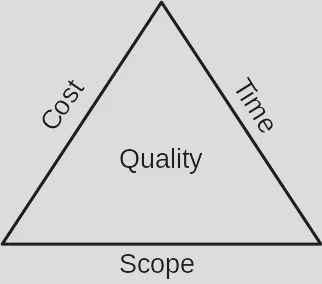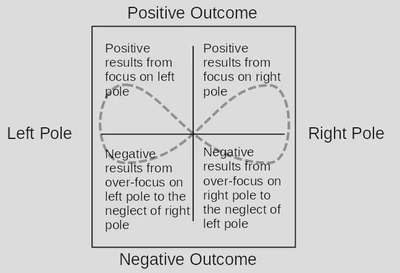'Strategic management of the triple constraint trade-off dynamics - a polarity management approach'
A standard view of project management holds that projects are governed by the triple constraint of time, cost and scope. This is often called the “iron triangle.” Changing one constraint will affect the others. For example, increasing the scope will either increase the cost or the time (or both.) Traditional waterfall type projects want to lock down all three constraints at the start, so spend lots of effort on defining requirements and estimating and adding buffers to prevent later cost overruns. This has not been particularly successful. Agile approaches fix the time (using a timebox) and cost (team size) and then vary the scope.

In “Polarity Management: Identifying and Managing Unsolvable Problems”, Barry Johnson introduced the concept of polarity management. When faced with opposing concepts, instead of viewing it as a trade-off between two mutually exclusive approaches, polarity management instead views them as two interdependent opposites to be managed. The two polarities must be balanced against each other from moment to moment. Johnson uses a quadrant chart to plot positive and negative outcomes from each polarity. The goal of successfully managing the polarities is to spend most of the time in the top two (positive) quadrants.

In the paper “Strategic management of the triple constraint trade-off dynamics - a polarity management approach” the authors try to combine these two concepts and apply polarity management to the trade-offs between two of the constraints that they deem to be more flexible. For example, they fix the time constraint and try to show a trade off between cost and scope. However, it is not clear at all to me that the these constraints form a polarity. Johnson describes two questions that he uses to distinguish polarities from problems to be solved.
- Is the difficulty ongoing?
- Are there two poles that are interdependent?
The two more flexible constraints are interdependent in that increasing the scope will increase the cost required. But this is a direct trade-off, it is not a moment-by-moment choice to increase the scope today then reduce it tomorrow. As the project progresses and new information becomes available (eg some tasks finish early or late) then a constraint can be changed. But that change is caused by new information, not by a balance between the constraints. Also, as Angelo Baratta points out in his critique of the triple constraint the cost is generaly a function of scope and time. So there are only two independent variables and if one is fixed there is no trade off - just a single constraint to determine.
The main difference I see between balancing project trade-offs and what is described by polarity management is that the project trade off is a single decision that is made, maybe at the start of the project, as to where the trade off should occur whereas polarity management is an ongoing balancing of approaches.
For agile projects, as noted above the goal is to remove the trade off completely by using scope as the single variable. The problem then becomes how to maximise the amount of value delivered given the time and cost constraints. This is similar to Angelo Baratta idea in where the triangle is replaced by a capability, scope, value triangle where value is a function of scope and capability.
Therefore, although polarity management is a very interesting idea, I don’t think it is applicable to managing the project constraints. However, reading that paper did stimulate my thoughts on project management.